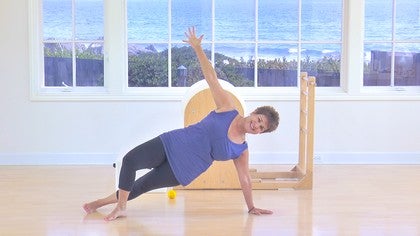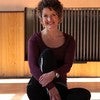Description
About This Video
Transcript
Read Full Transcript
I'm happy today to do this tutorial on planking. And I call it the proficient plank. A lot of times what happens when we do a plank exercise, we try to organize the client head position, shoulder position, core position, leg position, and we give them far too many cues during the exercise to help them make the exercise really effective. So what I'm going to do today is I'm going to take the plank and I'm actually going to break it way, way down. So the first thing we're going to do is right here on the barrel.
So I'm going to just take my feet back a little ways and I'm going to press my hands on the barrel. So right here in this position, this is basically a plank. So the further I move my legs back, I'm gonna do it. And it's going to get a little haywire here on purpose because I want to make a point as I take my feet further back and I lift up my heels, I can bring my plank forward and then I can pull my belly weigh in and squeeze my legs and engage. But if you look at my head position, my head is now extended. So how am I going to educate my neck? Well, that will come later in a fundamental workout. But what I'm going to do briefly, how many times have we said to a client, imagine you're holding an apple, a peach, a lemon, and orange or grapefruit.
I've chosen a lemon today because it fits my neck and I'm just going to put it underneath my neck. And then when I start to challenge my plank, you'll notice that it kind of holds my head in a nice stable position. So now I can challenge my plank and lift one leg and lift another leg and lift one arm and lift another arm. So then I can challenge my plank. But what I really challenging was the position of my neck. And I know personally that it's my neck that tends to take over in a lot of exercises.
So I have learned in my own body when to pay attention to my neck position. For example, sometimes when we do a plank, somebody will look like this, I'm gonna do it a little bit wrong, a little bit funky right now. They'll go like this and they'll be way out in their plank and their head will drop and then the teacher will say, Hey, don't drop your head. And so then the client might just do this, in which case they lift their head. I'm not going to do that very long cause that really bothers my neck when actually what we really want to happen from a dropped head position, we really just want the face to pull back and kind of the bridge of the nose to pull back so that we're in that position. Like we're holding that lemon.
So now this becomes a connector if you will, between the neck and the shoulders and the trunk and the back of the thighs. That's a whole workshop in and of itself. But just so you understand that, be careful where you queue because the problem way, it may not always be exactly where you think it is. So we take this plank here and we turn it to a side plank or the beginning of a site up if you will, and we hold ourself up tall. So I can just do it here and I'm going to notice the position of my body here is just level. As I challenge this and take my body out, you'll see that this is not a plank right here. This is a side bend. This is con vex on this side and concave on that side.
But we first have to recognize in a plank where level is. So now I'm going to bring myself level and I'm going to play here a little bit til I really feel where it is that I'm level. And again, I don't have anybody telling me if I'm level or not, but I'm feeling like I'm relatively level here. So now I'm just going to hold this. Now the more tired I get on my left oblique system, my body wants to start to extend because that's the strategy that my body uses to do it. So I'm going to take my trusty little lemon and I'm going to put it underneath my head. And you have to understand I'm not making lemonade with this lemon.
I'm not smashing the daylights out of it. I'm just holding it a little bit here with my arm out to the side and just recognizing where I am here at level. So now the integrity of the position of mine neck, my head over the mid part of my chest and my ribs over my pelvis that now this becomes star on the reformer. How about that? But now this is just done in standing. Whew. And that's just a lot of work. So we have to come from this position here, creating this, um, low load, if you will, to try to fire up all these deep stabilizers in the neck and in the trunk so that then we can carry it on to exercises like long stretch and star on the reformer.
So the next level from up here would be maybe on the box and maybe on our forearms. So it'll look a little bit like this. So I'm going to do it first, a little funky. So my forearms are going to be down here and I'm going to say, okay, here comes a really good plank and I'm going to try my hardest to do a really good plank. Oh Gosh. And then my teacher says, hey, drop your chest. And then I dropped my chest and I do this. I'm going to stop that. That doesn't Farrelly good. But you've seen that happen either in yourself or in somebody else at the gym when you're looking at them and saying, wow, that doesn't really feel great. So now I'm going to organize my chest and my shoulders. And again, there's a lot happening in the shoulders and shoulder blade with shoulder blades stability. It's not the focus right here to talk about all that. I just want you to recognize and bring into your bodies classroom, if you will, to try to feel the relationship of what wants to substitute.
So that was just a really kind way of saying, let's pay attention to what's happening in our body during different pieces of exercises. So we're going to take one leg out and I'm going to show you my pattern. My strategy is this. This is my strategy where I feel like I have a pretty good connection in my thighs and in my trunk, but my head was an extension. So I go back to my trusty lemon.
I'm going to hold it down, I'm going to get on my forearms, I'm going to hold my plank. So now what happens is the longer I hold this, I wonder which part of my body is going to get tired first and it doesn't really matter. I'm just paying attention. And then I'm going to bring myself down and bring myself down altogether. So then of course after that I can come up to my hands. I'm going to try to do it without the lemon now.
So now I'm going to take my hands on the board and I'm still not in a complete plank, but I'm at this level. I understand what my strategy is, but I want to reprogram and get a different one. So I'm going to take my chest over my arms. I'm going to take the bridge of my nose back and I'm going to attempt to make a straight line. Now again, I don't have a mirror here. I'm feeling this is pretty good because I can breathe and not get into my neck
So sometimes when when I hear people say, don't move something, I don't have a strategy to say how to help me do it. So now that we've created this understanding of kind of where the neck is and where the trunk is, we can kind of grab a mirror or put our iPad on the floor. And I've done that before where we can kind of notice where on body position is. So now we'll do it on our side. So I'm gonna take my forearm plank here. I'm going to take, I'm going to just do two legs with a wider base so I can chit chat while I do this. Because the other way it's kind of hard.
You'll notice here is my hip dropping down here is my hip way up. But here I hope is relatively stable. Again, my strategy is extend head and neck at all costs, but I don't have my lemon nearby, so I'm going to imagine now because I've given myself that lemon and now as my arm comes out, my breathing and voice are really nice. And when I started to get tired, I can stop the exercise and come out of it. That will build us to our side bend, twist, our seated twist, and any exercises we do in a side plank. So last one, let's take the box out of the way. Come to this quadrupled position.
And you know the Quadrat pad position is really a plank, isn't it? So let me just press my shins down and let me just notice the position of my pelvis to be in neutral and my head to be looking right down at that lemon. And that lemon is reminding me that I have to do a little deep cervical neck connector. So I'm going to hold my position, take one leg out, take an inhale, and as I exhale, take my other leg out and I hold this plank taking an inhale and an exhale. If I start to get tired in my core and my pelvis starts to drop and my head starts to go like this, I need to stop the exercise and I need to get regrouped. It's not worth it to hold it longer. If you can't keep the ideal position, I'm going to do it now with the lemon, just to remind myself.
And then we have a side plank. This is last one. So before we could even do side plank or side up on the reformer, we have to recognize where a true side plank is. So my hand actually has a start a little bit in front of my shoulder so that when I indeed come up into the plank, my shoulder is over my arm. So I'm just going to have the staggered stance here. Just for the sake of this demonstration here, and when I first bring myself up and to keep my right leg in front, I'm corely connected.
I pelvic floors lifting up a little bit and I'm opening up my chest. Notice here, this is too much side bending. This is too much dipping, but if I come to the level and I hold this right here, I know that my lemon is in place. I got my smile on, I'm going to hold right here and then I can stack and then I can hold and hold and hold. I felt my own head wanted to go back, so I needed to reconnect with my lemon and get that feeling and then bring yourself down and you can try it at home on your other side. Thanks.
The Successful Beginner: Movement Breakdowns
Comments
You need to be a subscriber to post a comment.
Please Log In or Create an Account to start your free trial.





















